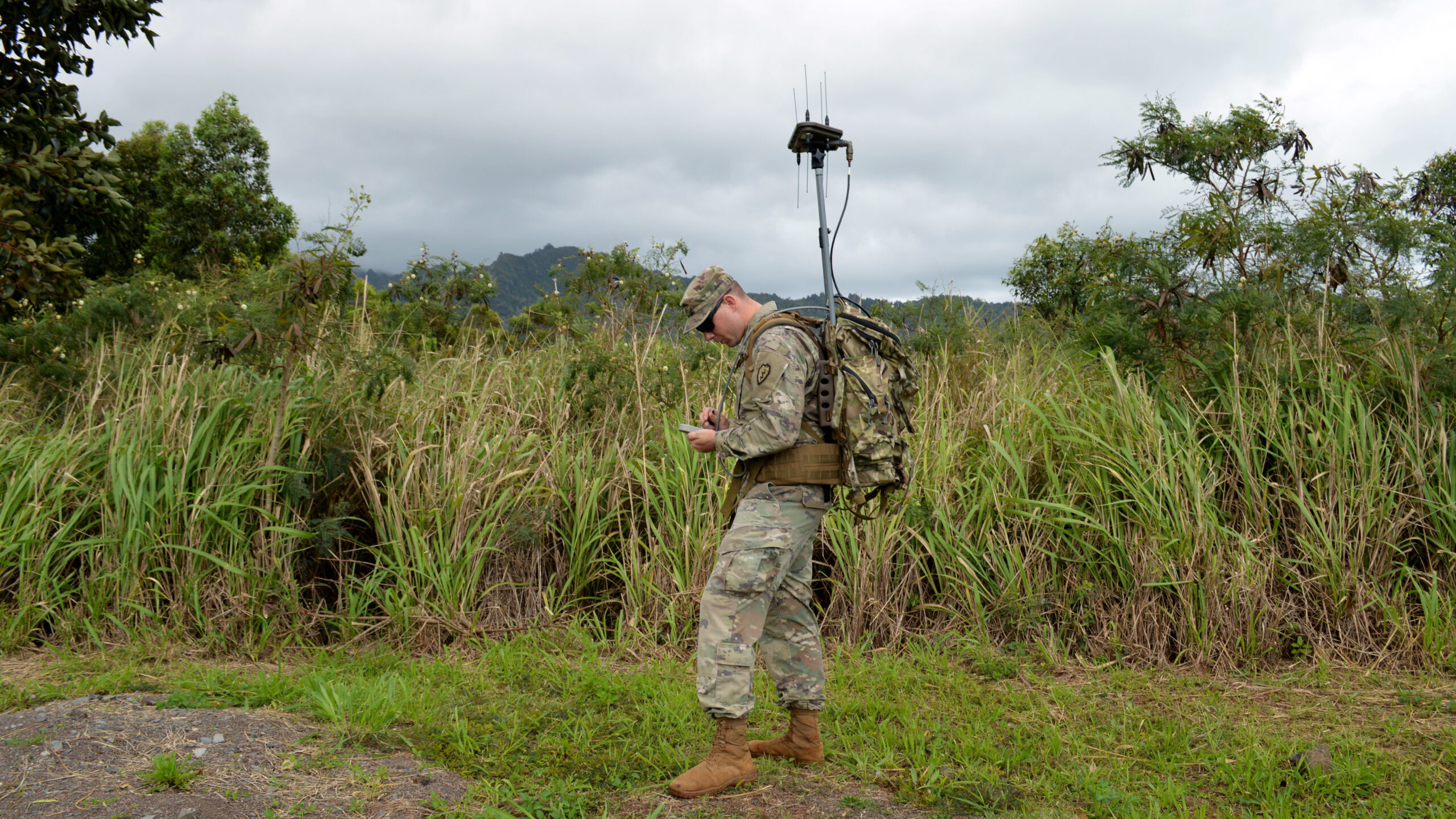
Sgt. Jessie Albert, an electronic warfare specialist with the 25th Infantry Division, trains on the Wolfhound Radio Direction Finding System at Schofield Barracks, Hawaii, on April 11, 2018. (Staff Sgt. Armando R. Limon/US Army)
WASHINGTON: As the Army revitalizes its electronic warfare systems after years of neglect, the service’s researchers at the C5ISR Center said they are developing several technologies that will make EW soldiers more effective on the battlefield, even if they can’t talk much about the tech specifically.
Instead, several Army researchers told Breaking Defense about the challenges they’re hoping to overcome: They need resilient EW systems that can stretch over greater distances to get close to enemies (or automated options if the link breaks), ways to sniff out enemy electromagnetic signatures that can reveal battlefield data and potential EW targets, and, finally, methods to know if an EW attack — generally a silent, explosion-less technical assault — did what it was supposed to do to enemy systems.
This is all in service of, and integrated into, the Army’s new warfighting concept known as multi-domain operations. The concept of MDO is how the Army plans to fight as part of the joint force against an adversary who can contest the US military across land, sea, air, space and cyber.
“The electromagnetic spectrum is not officially a domain, but operations on the electromagnetic spectrum are critical in order to realize the different phases of the multi-domain operations,” said Jeff Boksiner, senior research scientist for electronic warfare technology at the center. “[EW] will have different roles depending on where you are within the MDO just because MDO is defined by not just the phase operation, but also by the operational distances.”
Related: A prototype spy plane is tracking Russian force movements for the US Army
Electronic warfare can be used to interfere with enemy communications systems, interrupting their ISR, battlefield maneuvers and target acquisition processes. To develop the electromagnetic superiority the service needs, Boksiner said, the Army will need to use automation and machine learning to more quickly process battlefield information and alleviate cognitive burden on soldiers. He added that automation could also be used used to coordinate EW effects on the battlefield. Information overload, as Breaking Defense has previously reported, is a primary challenge in multi-domain operations.
To help deal with the greater distances, particularly envisioned by experts if the US ever has to take on China in the Pacific, the researchers at the C5ISR Center are also considering the possibilities of high-altitude platforms and distributed sensors, mixing sensors that are close to the enemy with ones that are far away, or a “layered” portfolio of battlefield capabilities.
“When we look at our traditional approaches things … for a while, have been done from really from a standoff perspective,” said Joe Plishka, integrated offensive electronic warfare branch chief. “But approaches that focus more on a layered approach — capabilities at different layers — are certainly something that we have to consider going forward in our research portfolio.”
In one specific example, the C5ISR researchers are diving into photonic signals processing, a complex method of rapidly processing signals. Boksiner added that they are also exploring atomic sensors, though that type of technology is still in the early research stage and years off.
The mix of sensors at different locations on the battlefield will also help the Army’s with its deep maneuvers and deep fires as it transitions back to large-scale combat operations, but that comes with distance limitations for radio frequency waves. Therefore, researchers are looking at how to maintain connection with dispersed sensors to overcome distances.
The researchers are fiddling with how to “get some of these capabilities to be autonomous, either through some network connection where we can maintain communication with them or in some free autonomous mode for them to be effective if we can’t establish some type of communication link,” said Bill Taylor, cyber technology division chief at the C5ISR Center.
But while the Army is trying to ensure its own networks and communication lines stay up, it also wants to be zeroing in on the enemy using their electronic “emissions.” Ultimately, the service wants to be able to identify what EMS emissions are associated with different formations and weapon systems, in order to understand what they’re doing on the battlefield and ultimately predict their next move.
One of the challenges for the Army’s science and technology community, according to Taylor, is that the EMS spectrum is “very dense,” and adversary systems operating in different frequency bands and ranges make them difficult to track.
“Our ability to be able to detect those RF emissions, sense them, understand them at a rapid speed at the pace of operation is challenging,” Taylor said.
Another area of research is how to provide battle damage assessment when the Army conducts an EW attack on the enemy. The invisible nature of the electromagnetic spectrum makes it challenging for commanders to see if an attack impacted its intended target. Taylor there’s no “smoking hole in the ground or some destroyed equipment” to physically show a commander the result of an attack.
“Giving commanders that are not familiar with the use of electronic warfare as a means of fires the confidence that these capabilities are key tool in their tool chest of capabilities to provide challenges to the adversary and operation is something that we want to make sure that we can provide,” Taylor said.




















